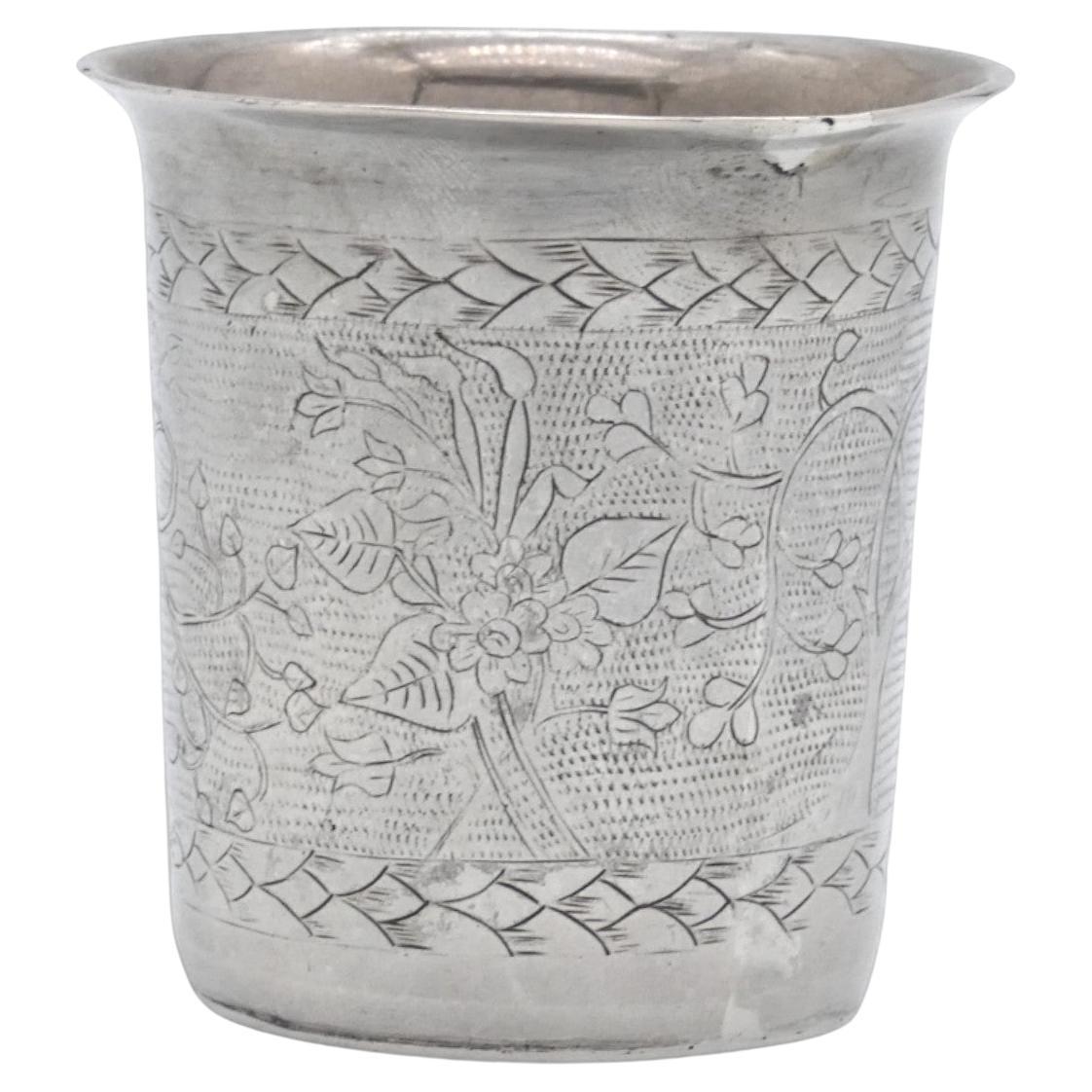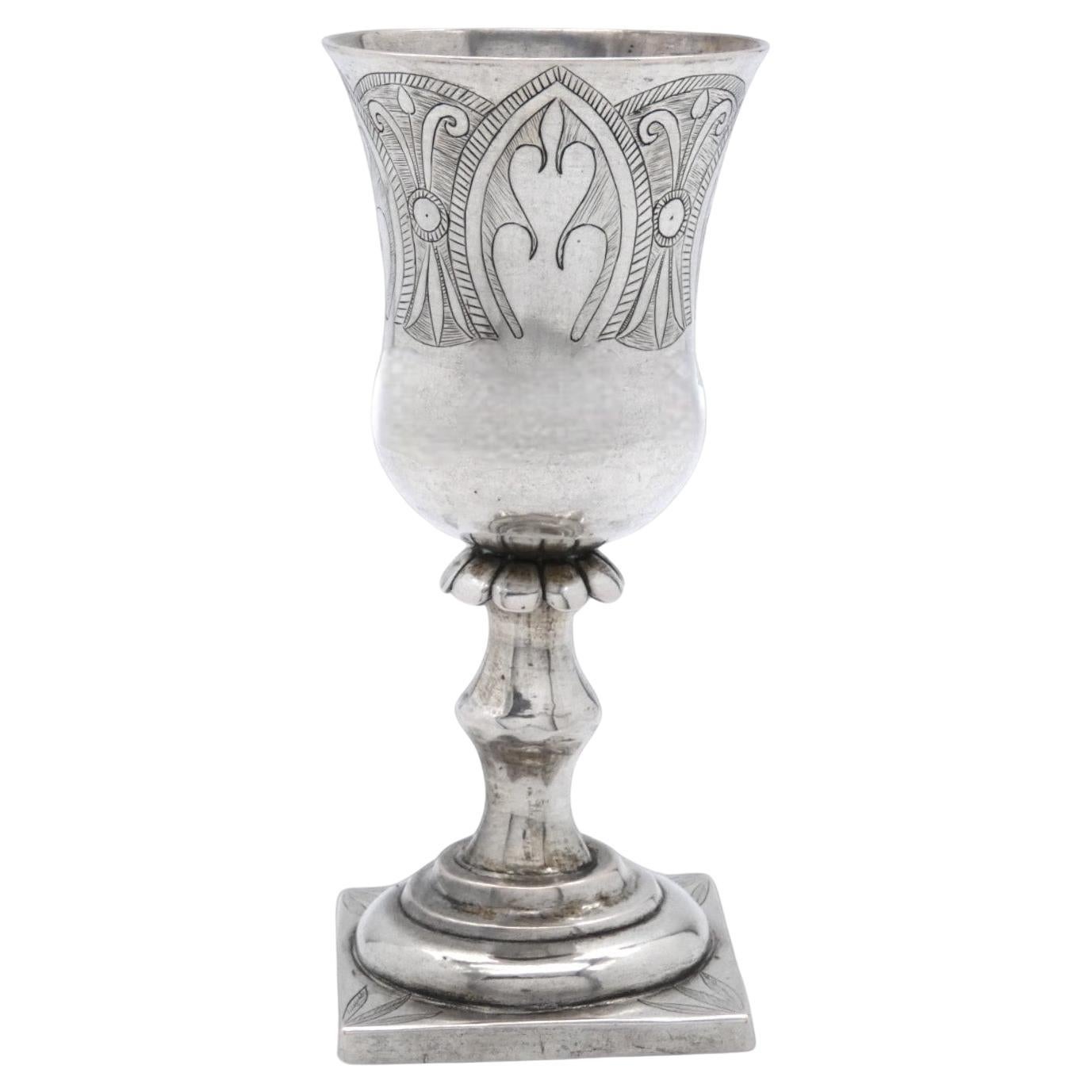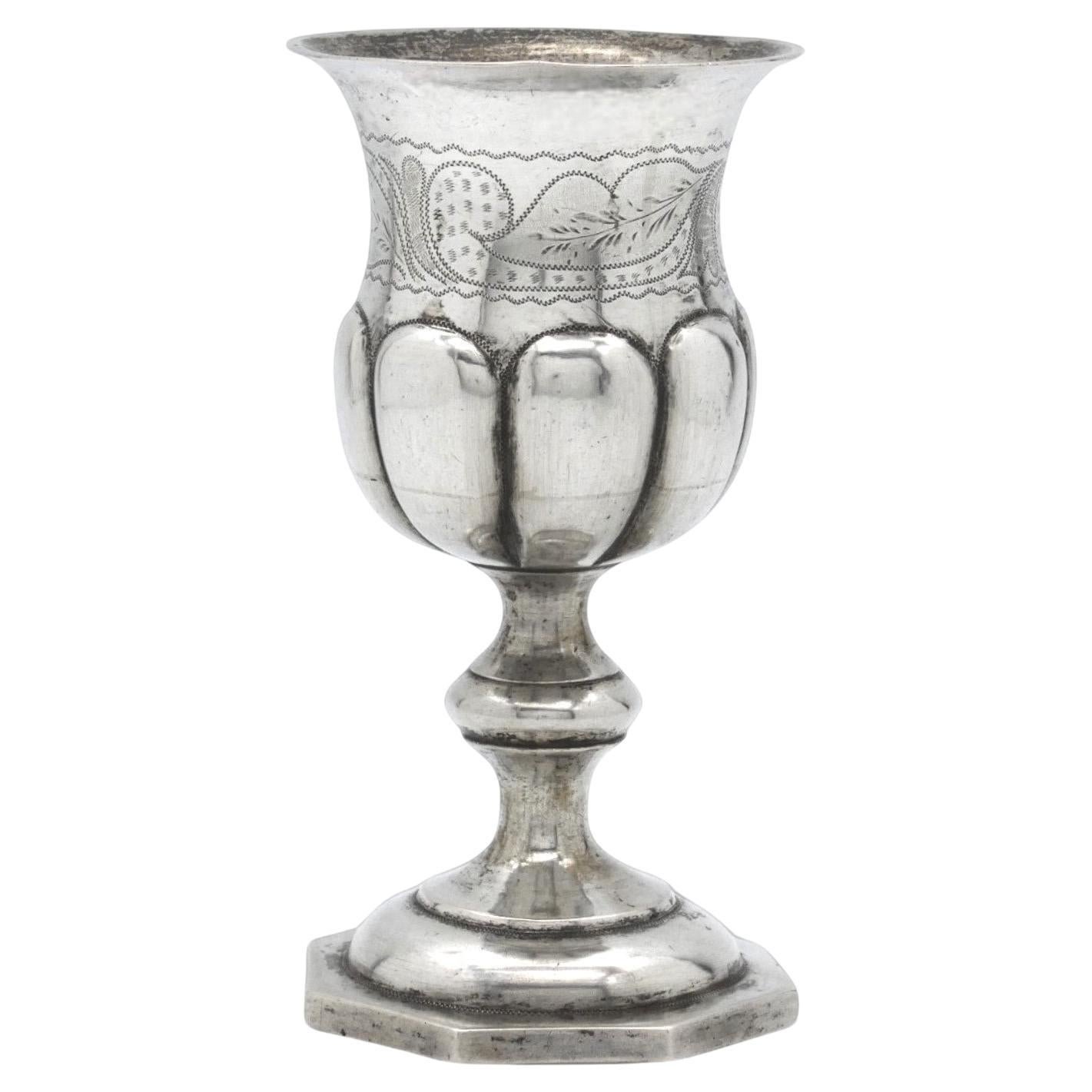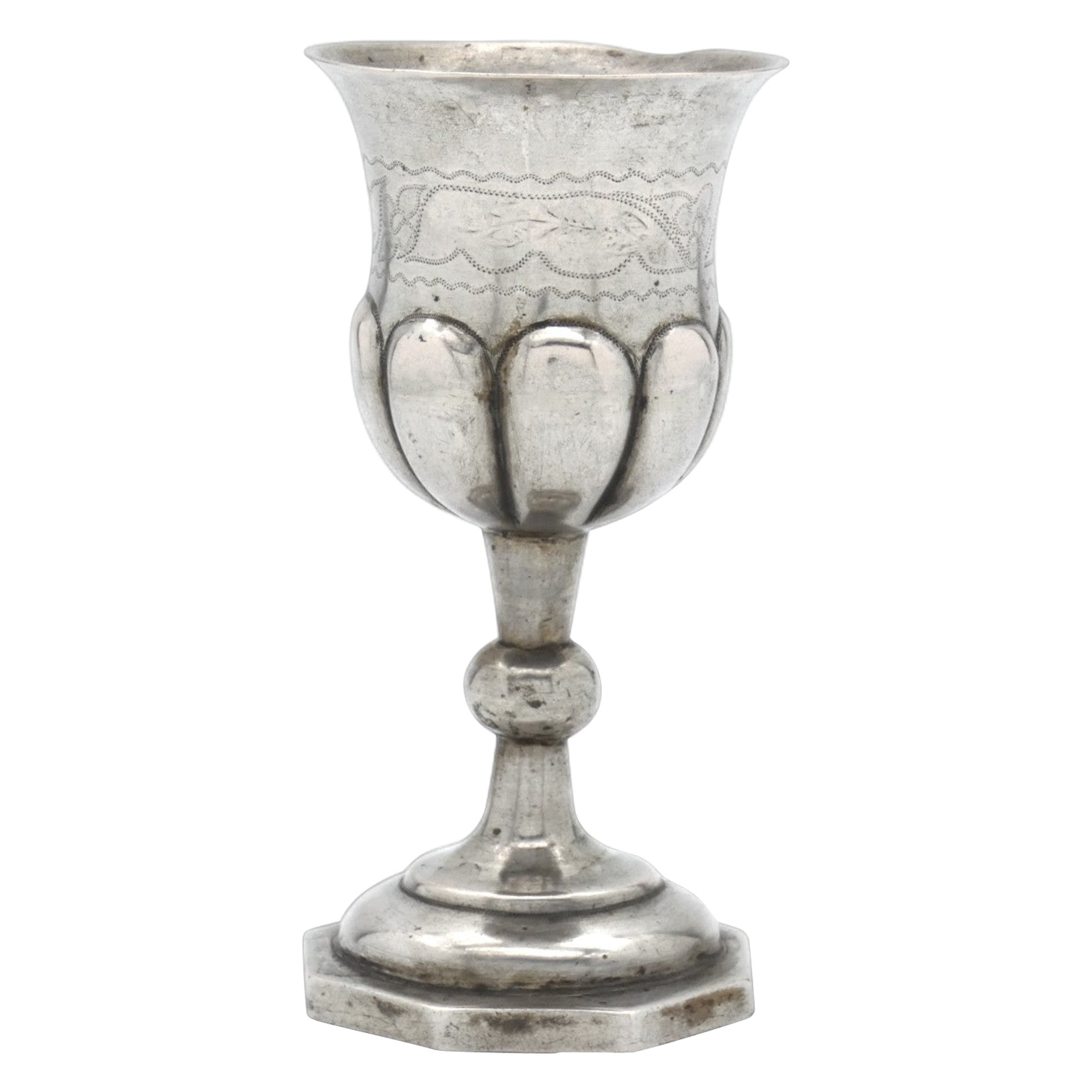Items Similar to Rare "Safed" kiddush cup, late 19th century Poland/ Eretz ISRAEL
Want more images or videos?
Request additional images or videos from the seller
1 of 5
Rare "Safed" kiddush cup, late 19th century Poland/ Eretz ISRAEL
About the Item
This 84 silver cup was made in Europe, in Poland or parts of Poland that are in modern Russia in the 19th century, the interesting and important in this cup types is that they were sent or brought over to Eretz Israel in the late 19th Century and they were engraved by a famous engraver in the holy city of Safed on the north of Israel, with this act the kiddush cup was getting the "holiness" of the promised land in it, the decoration is just amazing on this Cup and the interesting and rare part here is that most of the times this cups Are simple without a fluted base like we have here in the example, the cup Is marked 84 for the 87.5% of silver content 5 times to the base. Three Medallions delicately engraved with decorations showing the Western Wall, The Cave of Machpelah and the Tombs of the Davidic Kings. Interspersed Between the medallions are engraved decorations of leaves and flowers.
A great addition to any serious Judaica collection or any jewish house.
Size:
Height : 4.6 inch / 11.7 cm
Width : 2.6 inch / 6.5 cm
- Dimensions:Height: 4.6 in (11.69 cm)Diameter: 2.6 in (6.61 cm)
- Materials and Techniques:
- Place of Origin:
- Period:
- Date of Manufacture:1890
- Condition:some minor dents and scratches, consistent with age.
- Seller Location:Tel Aviv - Jaffa, IL
- Reference Number:1stDibs: LU8130237709242
About the Seller
No Reviews Yet
Vetted Seller
These experienced sellers undergo a comprehensive evaluation by our team of in-house experts.
1stDibs seller since 2023
Typical response time: 1 to 2 days
- ShippingRetrieving quote...Ships From: Tel Aviv - Jaffa, Israel
- Return PolicyThis item cannot be returned.
More From This SellerView All
- Very Rare 18th Century Judaica Kiddush Cup, Rothschild Family ProvenanceLocated in Tel Aviv - Jaffa, ILThis is a rare German silver kiddush cup that was made in Hochhausen (Tauberbischofsheim) or In the area, the marks on the cup relate to German silver in the 18th century, there Is a loth 13 silver mark which is 812,5 silver fineness. A Jewish Community in Hochhausen has been known since the 17th century. In 1706, four Jews from Hochhausen were named, each of whom had to pay ten Guilders for protection money. The Jewish Community in Hochhausen owned a synagogue, a Jewish school, The Jewish cemetery in Hochhausen and a ritual bath, which adjoined the Property at Mühlenwörth 7. The bathing house that was probably there was about 3 m by 4 m and got the water of the Tauber via a small canal from the Mühlkanal. The ritual bath came into the possession of the mill around 1920 and was Probably filled in at the time. A separate religious education teacher was Employed, who also worked as prayer leader and schochet. In 1827 the Jewish Community in Hochhausen was assigned to the district rabbinate of Wertheim, Which temporarily had its seat in the Jewish Community of Tauberbischofsheim From 1850 to 1864. The cup is adorned with an amazing engraving in old German style says : Familie Rothschild Hochhausen We can see that the family member that ordered this cup from a silversmith was Proud in his family name as he asked it to be engraved in such bold germanic Style letters. The font type is Fraktur it is a calligraphic hand of the Latin alphabet and any of Several blackletter typefaces derived from this hand. Letters are designed such That the individual strokes are broken apart; in this way it is often contrasted with The curves of the Antiqua (common) typefaces where the letters are designed to Flow and strokes connect together in a continuous fashion. The first Fraktur typeface arose in the early 16th century, when Emperor Maximilian I commissioned the design of the Triumphal Arch woodcut by Albrecht Dürer and had a new typeface created specifically for this purpose, designed by Hieronymus Andreae. The Rothschild family...Category
Antique Mid-18th Century German Sterling Silver
MaterialsSilver
- A RARE SILVER SHMIROT KIDDUSH CUP. Galician, c. 1850.Located in Tel Aviv - Jaffa, ILA RARE SILVER SHMIROT KIDDUSH CUP. Galician, c. 1850. Among some Hassidic courts, it was a practice for the Rabbi to give a blessed silver coin to his Hassidim as an amulet. Such protection might be given for all manner of life events, from healing from an illness to success in travel and the amulet was carried on the body of the recipient. This custom was particularly popular among the Ryzhiner Hassidim and these coins were called "Shmirot". To such coins were attributed extraordinary power and value and they were treasured with great care and love. this cup is marked with polish loth 12 mark which indicate silver content of 75%. Size : Height 2.3 inch / 6 cm Width : 2 inch / 5 cm After the specific event for which they had originally be given, such a coin or coins were used in the making of other objects, which maintained the special aura of the Rabbi. Such a coin would be melted in other silver with the amuletic valued being spread evenly to all the silver. Then a ritual object would be fashioned by a silversmith and the special nature of the item would be inscribed on it, indicating in one of several ways that this object had been made from "Shmirot". this objects include Kiddish cups, a Havdalah tray, a Shabbat salt holder, a Chanukkah Menorah, a Torah crown etc. This object is a Kiddish cup fashioned from such silver. On this cup, the inscription indicating Shmirot is found in the abbreviation of the words "made from shmirot k (kodesh)' " (This is the cup of Shmirot). Such cups were used for blessing the wine so that each use renewed the power of protection granted by the Rabbi. This cup was used for the blessing over wine on Shabbat and holidays. Inscription: the other iconography on the cup is of a lion that represent Through the tribe of Judah, the lion symbol came to represent the blessing, majesty, and even divine protection of the Jews. The lion symbol continued to be used even after the destruction of Jerusalem, the capital of Judah's nation, and a unicorn or a re'em, also reëm (Hebrew: רְאֵם), is an animal mentioned nine times in the Hebrew Bible It has been translated as "unicorn" in the Latin Vulgate, King James Version, and in some Christian Bible translations as "oryx" (which was accepted as the referent in Modern Hebrew),[citation needed] "wild ox", "wild bull", "buffalo" or "rhinoceros". Rabbi Natan Slifkin has argued that the re'em was an aurochs, as has Isaac Asimov...Category
Antique 1850s Sterling Silver
MaterialsSilver
- Important Early 20th Century Silver Kiddush cup by Bezalel School JerusalemLocated in Tel Aviv - Jaffa, ILImportant Handmade sterling silver Kiddush goblet by Bezalel School, Jerusalem, Circa 1910-1913. On the cup there are 3 identical scenes of flanked lions and on the middle of them There are two columns with a staircase, this design is probably taken from Eastern European torah ark, on the middle part there is a chandelier with 3 tiger/lioness Heads, the top of the cup has 3 inscription on top of each flanking lions scene, first One says : ״כוס ישועות אשא״ (Psalms 116:13) which means " I will take the cup of Salvation", this is a rather common blessing on kiddush cups. Next inscription says : ״אין שמחה אלא ביין״ in English " there is no joy except in wine" This says that after the temple was destroyed we have our joy only in the wine of Kiddish. The last inscription says ״ושמחת בחגך״ (Deuteronomy 16:14 ) in English : "And you shall rejoice in your festival". So this cup is a kiddish cup...Category
Vintage 1910s Israeli Art Nouveau Sterling Silver
MaterialsSilver
- Mid 20th Century Silver Kiddush, Eliyahu Hanavi cup by Bezalel School JerusalemLocated in Tel Aviv - Jaffa, ILImportant Handmade sterling silver Kiddush (eliyahu hanavi cup) goblet by Bezalel School, Jerusalem, circa 1948. On round base decorated with silver filigree and Cabouchon shaped o...Category
Vintage 1940s Israeli Aesthetic Movement Sterling Silver
MaterialsAgate, Silver
- Important Early 20th Century Silver Kiddush Goblet by Bezalel School JerusalemLocated in Tel Aviv - Jaffa, ILImportant Handmade sterling silver Kiddush goblet by Bezalel School, Jerusalem, circa 1910-1913. On round base decorated with silver filigree and Cabouchon shaped green agate applications. The base fitted with Bezalel mark. The upper portion is all adorned with amazing filigree work, the base and the actual cup adorned with swirling filigree designs, in the middle there are 3 roundels, made in another technique of hammered silver, similar to the works that were produced in this time all over Europe, in the middle of each roundel there is a perfectly centered Cabouchon green agate. This work is attributed to Yehia Yemini. The goblet is marked on the base, with the earliest silver mark of the school that just say "Bezalel" in Hebrew. Yehia Yemini : Was one of the biggest and must famous Bezalel silver...Category
Early 20th Century Israeli Jugendstil Sterling Silver
MaterialsSilver
- An Israeli sterling Silver Tzedakah box, Judaica, by Carmel Shabi, 1994Located in Tel Aviv - Jaffa, ILTzedakah box of flattened oviform shape (round fish shape) , amazing sleek and Modernistic design. just a masterpiece of design. Pierced with stylized H...Category
1990s Sterling Silver
MaterialsSilver
You May Also Like
- A Silver Kiddush Cup, Poland 19th CenturyLocated in New York, NYA Nicely Engraved Silver Kiddush Cup made in Poland in the 19th Century. Classic Polish kiddush cup that was commonly found in many households duri...Category
Antique Late 19th Century Polish Sterling Silver
MaterialsSilver
- A Silver Kiddush Cup, Poland mid 19th CenturyLocated in New York, NYA Tasteful Silver Kiddush Cup, made in Poland in the mid-19th Century. The Kiddush beaker is set on a flat base and its main body has a cylindrical shape with a flaring lip. Engrav...Category
Antique Mid-19th Century Polish Sterling Silver
MaterialsSilver
- A Silver Kiddush Goblet, Poland 19th CenturyLocated in New York, NYAn Elegant Silver Kiddush Goblet, made in Poland in the 19th Century This Goblet is more elaborately designed than most Kiddush goblets from Poland. The foliate motifs that are engr...Category
Antique 19th Century Polish Sterling Silver
MaterialsSilver
- A Silver Kiddush Goblet, Poland mid 19th CenturyLocated in New York, NYA Polished Silver Kiddush Goblet, made in Poland in the mid-19th Century. Kiddush Goblet is set on an octagonal base with a circular stepped domed base and a knopped cylindrical ste...Category
Antique Mid-19th Century Polish Sterling Silver
MaterialsSilver
- A Silver Kiddush Goblet, Poland mid 19th CenturyLocated in New York, NYA Cute Silver Kiddush Goblet, made in Poland in the mid-19th Century. Kiddush Goblet is set on an octagonal domed stepped base applied to a cylindrical ball stem. The applied cup i...Category
Antique Mid-19th Century Polish Sterling Silver
MaterialsSilver
- A Silver Kiddush Goblet, Poland mid 19th CenturyLocated in New York, NYA Refined Silver Kiddush Goblet, made in Poland in the mid-19th Century. This Polish Kiddush Goblet has an interesting feature about it. On the upper body, there is a Hebrew verse e...Category
Antique Mid-19th Century Polish Sterling Silver
MaterialsSilver
Recently Viewed
View AllMore Ways To Browse
Antique Welding
Russian Silver Cup
Antique Judaica
Antique Sterling Silver Russian
Kiddush Cup
Kiddush Cups
Sterling Judaica
Sterling Silver Judaica
Silver Kiddush Cup
Antique Judaica Silver
Antique Silver Judaica
Antique Russian Silver Cup
Sterling Cup Kiddush Cup
Sterling Kiddush Cups
Sterling Silver Kiddush Cup
Antique Welding Glasses
Modern Kiddush Cups
Judaica Kiddush





